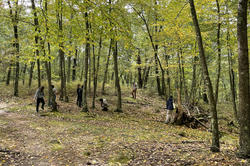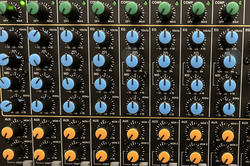A fall Digital + Media studio focuses on art and artists who intentionally deploy camouflage and invisibility in their chosen disciplines.
Digital + Media Studios Offer Glimpse of RISD’s Upcoming Sound BFA Program

As RISD prepares to launch the Computation, Technology and Culture (CTC) concentration as a new academic department, two Wintersession courses offered through Digital + Media—Environmental Sound and Sound Design—offer a glimpse of the key tools, concepts and principles Sound majors can expect in the coming years.
“There has always been a lot of crossover between CTC and Digital + Media,” says Professor Shawn Greenlee 96 PR, who heads up RISD’s Studio for Research in Sound and Technology (SRST). “These two courses are great examples of how students are expanding their practices to focus on conceptual sonic work and sound design across media formats.”
Music technology expert Chris Mayes-Wright taught the Environmental Sound course, which challenges the principles of studio-based music composition by using natural and built settings as stimuli for multi-channel sound creations. The course encourages students to explore the foundations of conventional composition—such as rhythm, harmony and melody—and investigate the concepts of space as it relates to sound.


On a sub-zero January day, the class traveled to RISD’s Tillinghast Place property on the Narragansett Bay, equipped with audio recorders, shields to block out the sound of wind, headphones, spare batteries and handwarmers for their pockets. Their goal was to capture natural sounds from the environment and incorporate them into their sonic compositions in progress.
“Think about the kinds of sounds you want to capture,” Mayes-Wright advised as he handed out the equipment. “How will they complement or contrast the sounds you have already collected from the built environment on campus? Are you interested in the sound of waves? Or the rustling of dry vegetation?”
The students braved the weather to record the snow crunching under their boots, gentle waves rolling in on the beach and a huge raft of ducks floating on the breakers. “Most of the students in this class are undergrads,” Mayes-Wright noted. “Some of them are musicians who have dabbled in composition before, but others are completely new to audio.”

As the term came to a close, the class prepared to return to Tillinghast to present their completed compositions through a portable, 12-foot cube speaker array they built on the mezzanine of 15 West. The experience, Mayes-Wright explained, taught them about the components and setup of a multichannel audio playback system, the ideal tool for presenting compositions created using digital audio workstation (DAW) software.
Back on campus, students in the Sound Design course led by Brown University PhD candidate Will Johnson used RISD’s 25.4 spatial audio array to explore techniques and develop their own pieces for real, “irreal” and hyperreal spaces. Through critical listening, readings and discussion, they worked through the possibilities and constraints of using sound to shape environments.
First-year student Leyla Gasimova 28 EFS shared a short piece that traveled through the space in unpredictable ways: a distant siren sounding in the back corner of the room, a rumbling bass that moved from one speaker to the next, snippets of conversation and laughter. “I like the way you’re using the ambient noise,” Johnson said. “By spatializing it and adding some reverb, you have reduced the noise floor without diminishing the signal.”


Grad student Wen Zhang MFA 26 PH played a layered piece she created using recorded poetry, her own voice and the sound of breaking glass, among other things. Johnson appreciated the way she held off on adding a drum track until well into the piece, instead creating an intricate rhythmic pattern with the sound of her feet walking and the mix of voices. “It sounds like internal dialogue,” one of her classmates offered, “the voices you hear in your head.”
First-year student Aoife Davoren 28 EFS explained that she began her project by taking a long walk wearing unplugged headphones and just listening to the sound of her own body. Johnson found the texture of the resulting piece to be interesting and loved the idea of listening to oneself. “Björk did a whole record using just breath and mouth sounds,” he told the class. “Setting constraints on your process can be really productive.”
Top photo: grad student Ricky Vasan MFA 26 PT records waves at Tillinghast Place.
Simone Solondz / photos by Kaylee Pugliese
February 13, 2025


